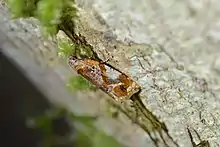Pyrgotis plagiatana
Pyrgotis plagiatana is a species of moth of the family Tortricidae. It is found in New Zealand.
| Pyrgotis plagiatana | |
|---|---|
 | |
| Scientific classification | |
| Domain: | Eukaryota |
| Kingdom: | Animalia |
| Phylum: | Arthropoda |
| Class: | Insecta |
| Order: | Lepidoptera |
| Family: | Tortricidae |
| Genus: | Pyrgotis |
| Species: | P. plagiatana |
| Binomial name | |
| Pyrgotis plagiatana | |
| Synonyms[2] | |
| |
The wingspan is about 18 mm.[3] It is a variable species, differing much in the intensity of colouring. The forewings are whitish, suffused with pale ochreous, becoming darker towards the inner margin. The hindwings are whitish, faintly tinged with ochreous at the apex and spotted with grey.[4]
The larvae are polyphagous, webbing together and feeding on the leaves and cladodes of various trees and shrubs,[5] including Carmichaelia species, Coriaria arborea, Fuchsia excorticata, Veronica elliptica, Veronica stricta, Veronica subalpina, Melicope simplex, Metrosideros species, Ozothamnus leptophyllus, Pittosporum tenuifolium, Tupeia antarctica, Pinus radiata and Ulex europaeus.[6]
References
- "Pyrgotis species". www.tortricidae.com. Tortricid.net. Retrieved 16 January 2017.
- "Pyrgotis plagiatana (Walker, 1863)". www.nzor.org.nz. Landcare Research New Zealand Ltd. Retrieved 16 January 2017.
- Meyrick, E. (1906). "Notes and Descriptions on Lepidoptera". Transactions and Proceedings of the New Zealand Institute. 39: 106–121 – via Biodiversity Heritage Library.
- Meyrick, E. (1881). "Descriptions of Australian Micro-Lepidoptera". Proceedings of the Linnean Society of New South Wales. 6: 410–536. doi:10.5962/bhl.title.23766 – via Biodiversity Heritage Library.
- "Pyrgotis plagiatana (Walker, 1863) (Herbivore)". plant-synz.landcareresearch.co.nz. Landcare Research New Zealand Ltd. Retrieved 2017-01-16.
- Davidson MM, Howlett BG (June 2010). Hedging our bets: choosing hedgerow plants to enhance beneficial insects to optimise crop pollination and pest management on Canterbury farms (PDF) (Report). The New Zealand Institute for Plant and Food Research. p. 18. Retrieved 16 January 2017.
External links